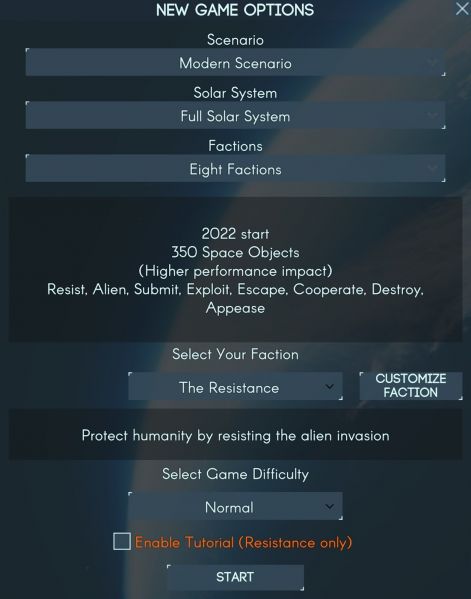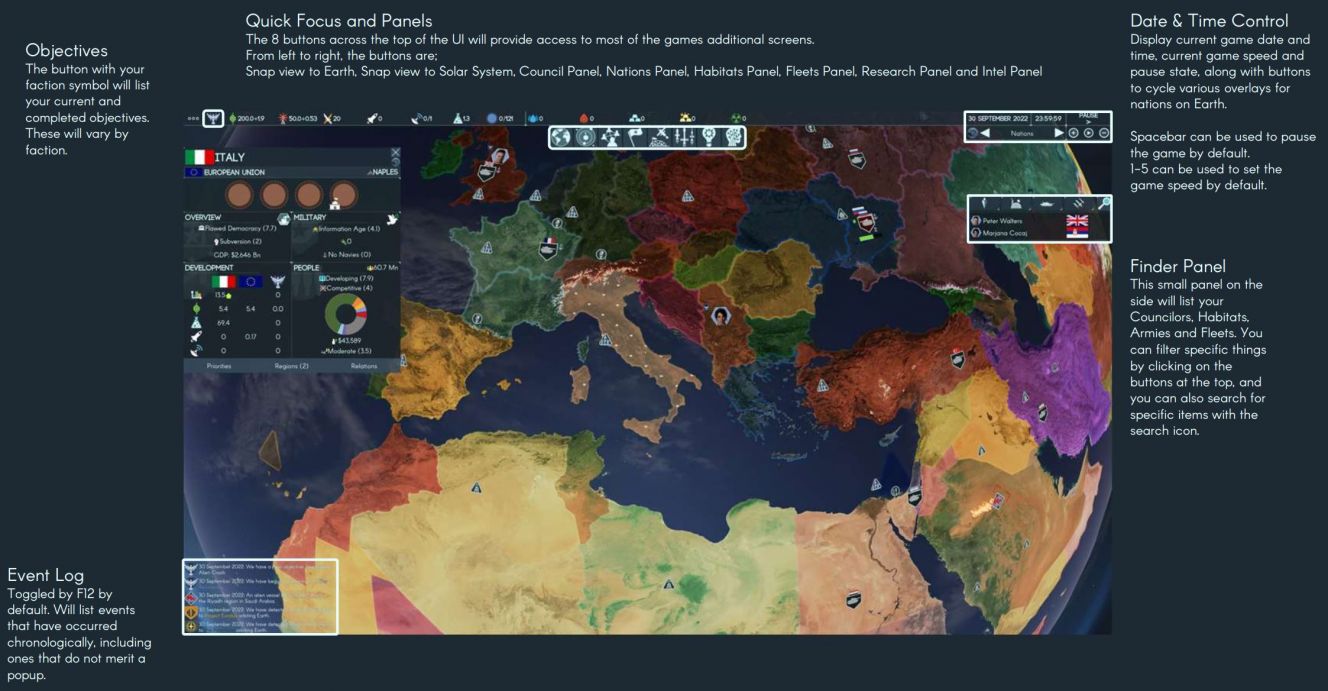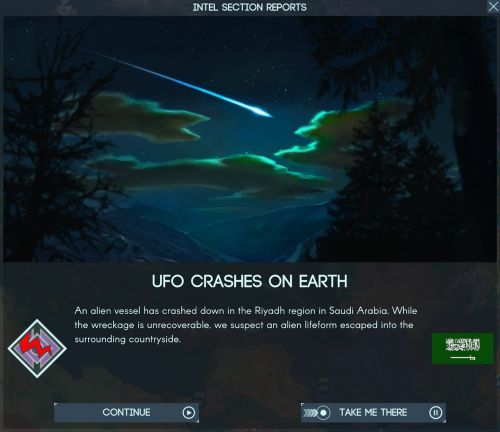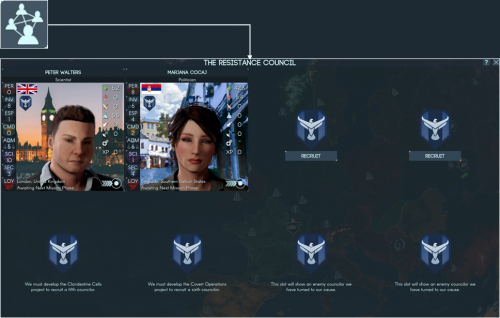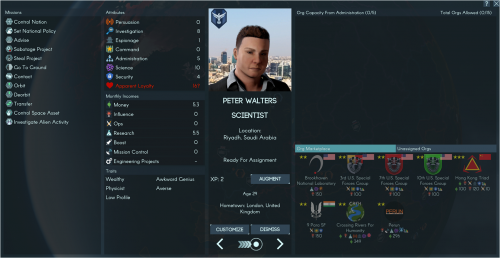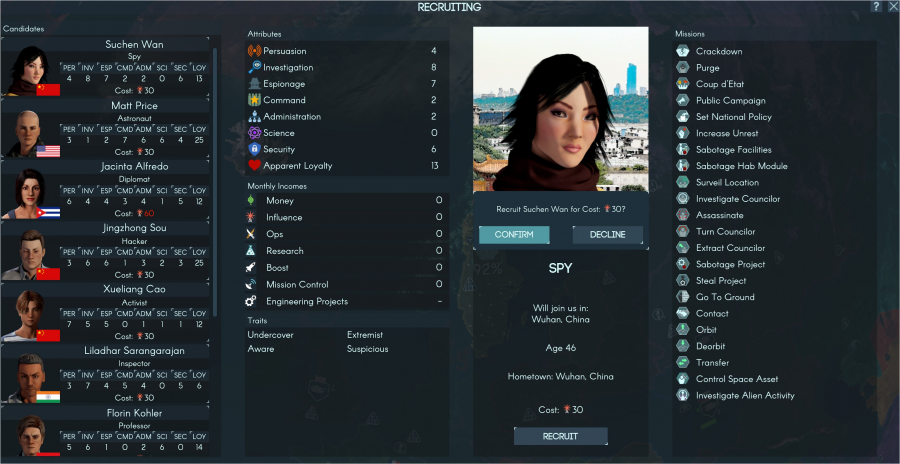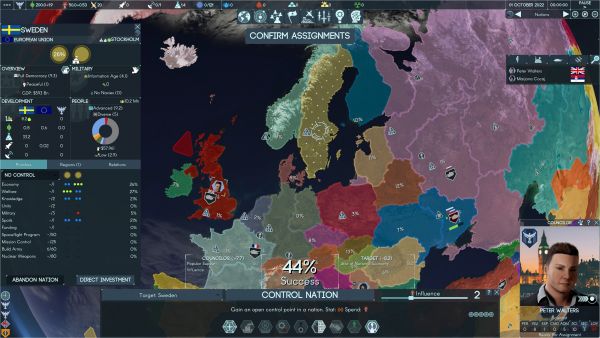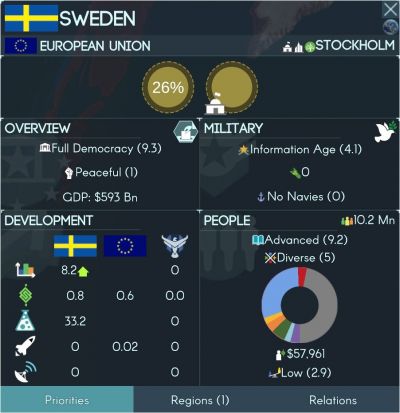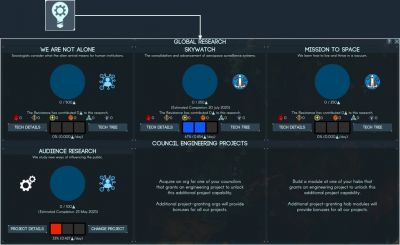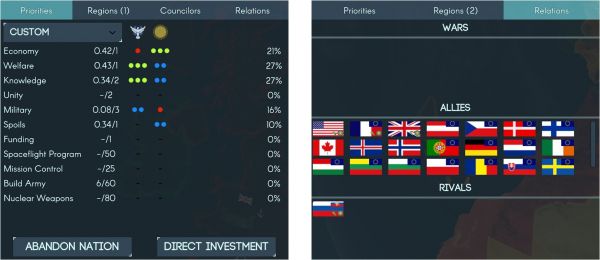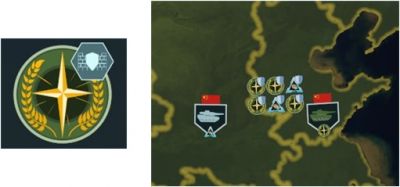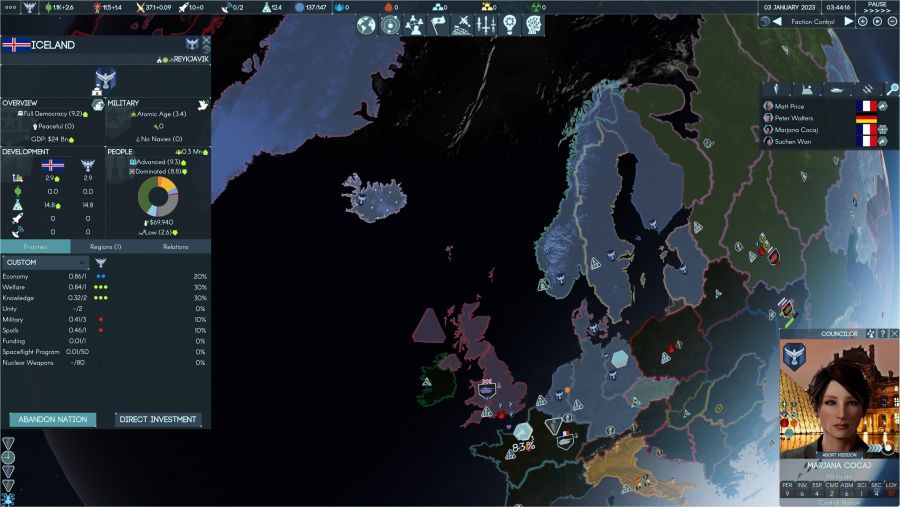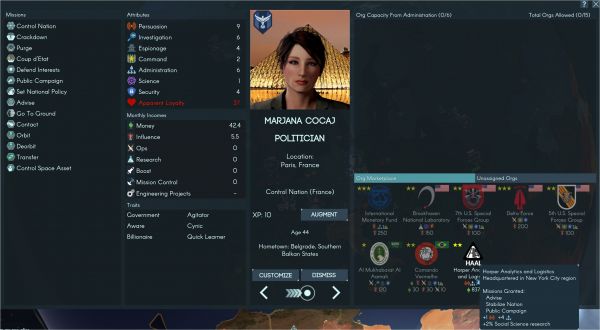Beginner's Guide: Difference between revisions
| Line 307: | Line 307: | ||
The amount of resources a site produces is randomly generated within certain upper and lower bounds. Some bodies, like [[Ceres]] or [[Europa]], tend to have plenty of Water because of the presence of water ice, while on Luna Water is relatively rare. | The amount of resources a site produces is randomly generated within certain upper and lower bounds. Some bodies, like [[Ceres]] or [[Europa]], tend to have plenty of Water because of the presence of water ice, while on Luna Water is relatively rare. | ||
Water and Volatiles are used to maintain stations and outposts while Base Metals as well as Noble Metals are mainly used to build them. Fission Piles require Fissiles. An important concept to understand how space industry works is that while resources needed from Earth cost Boost to send, '''space resources go into a pool that is shared by all your space stations and outposts without transfer times or other costs'''. For example, if you are mining Water on Mars, that Water is immediately available for a space station in Earth orbit. It may help to think of the solar system as split into two resource pools: Earth and space. | |||
Your goal is to start mining and accumulating enough of all these materials that you can start launching just cores from Earth using Boost and then completing the base using the five space resources, which saves time and huge amounts of Boost. | Your goal is to start mining and accumulating enough of all these materials that you can start launching just cores from Earth using Boost and then completing the base using the five space resources, which saves time and huge amounts of Boost. | ||
==== Your First Mine ==== | ==== Your First Mine ==== | ||
Revision as of 08:42, 1 October 2022
Starting a New Game
After selecting ‘New Game’ on the main menu, you will be presented with the following. For this guide, these are settings that have been used.
Solar System and Faction count can be adjusted freely, and parts of the guide will be applicable to all factions, but certain story related events, etc. will differ if you choose to play as someone other than the Resistance.
Enabling the tutorial will provide some additional guidance in game about basic features.
Strategic UI Overview
The screenshot below highlights some key UI features:
- Objectives
- Quick Focus and Panels
- Date & Time Control
- Finder Panel
- Event Log
Events
When you first start, you will also have an Event popup in the middle of your screen. When these occur, the game will automatically pause.
Significant events that occur, along with Councilor mission reports, will have a similar pop up later on in the game. Generally these will have 3 options (along with some additional ones for repeatable missions):
- Continue – will close the popup and unpause the game.
- Close – will close the popup, but leave the game paused.
- Take Me There – will close the popup and keep the game paused, and snap the camera to relevant location on Earth or in the Solar System.
The First Days
Councilor Assignment Phase
The game initially starts paused, shortly before the first Councilor Assignment Phase. These are one or two week cycles during which your Councilors will complete the missions assigned to them.
The first thing we need to do (after reading through our initial events) is to unpause the game (spacebar or 1-5 by default) and let it run until it automatically pauses again, and the CONFIRM ASSIGNMENTS button appears at the top of the UI.
The Council
The Councilor Assignment Phase is where you decide what missions your council will be doing during the next cycle. Your council is composed of up to 8 characters from various walks of life.
You may note that right now you only have 2 councilors listed in the Finder Panel on the right of the screen. You start with the capacity for 4, and this can be increased to 6 via technology. (You need to develop the Clandestine Cells project to recruit a fifth councilor, and to develop the Covert Operations project to recruit a sixth councilor.) In addition to this, you can have up to 2 enemy councilors that you have turned to your cause.
Therefore, the first thing we need to do is to figure out who in our council should do what this cycle, and what gaps in our line-up we need to fill by hiring additional councilors.
To do this, we can click on the Council Panel button just above the CONFIRM ASSIGNMENTS button to open the relevant panel.
The Council Panel presents an overview of your current council, and a brief summary of their attributes.
By clicking on the portrait of one of your councilors, you will be taken to a more detailed screen with information on them, including the missions they are capable of, their attributes and incomes, their traits, and organizations controlled by them as well as available for purchase or assignment.
Of interest to us here initially is mainly what missions they are capable of, and their attributes.
The first stage of the early game is about getting a foothold on earth, and to do this requires either taking uncontested ‘Control Points’ (CP) or taking over CP already controlled by another faction – these are done via different missions, and use different attributes.
Uncontrolled CP are taken using the Control Nation mission, which is governed by the Persuasion attribute.
CP controlled by another faction are taken using the Purge mission, governed by the Espionage attribute.
CP can be made more vulnerable to Purges by the Crackdown mission. This is governed by the Investigation attribute. Crackdowns will also remove the benefits provided by a CP to an enemy faction.
Take a moment to look through your two councilors. In addition to the above, it is also worth paying attention to their Administration stat, any possible Income (note this is monthly, whereas the resource panel is daily by default), along with their Traits (which can affect how they perform on mission and their incomes significantly).
Recruiting Councilors
Once you have done that, return to the Council Panel, and lets take a look at hiring a third councilor, by hitting ‘Recruit’ either on one of the empty slots, or at the bottom of the Council Panel.
This will open a page with a list of candidates on the left side – clicking on them will provide information similar to what you were provided on your own councilors.
New councilors cost either 30 or 60 Influence to recruit. As we only start with 50, we will only be able to fill one of the two free slots we have.
Bearing what was described above in mind, and depending on your initial councilors, you will want to pick someone out to round out your roster. If you already have 2 councilors capable of the Control Nation mission, then hiring one capable of the Purge and Crackdown missions might be a good move. If you only have one councilors capable of the Control Nation mission, I would hire a second councilor with that mission available. In both cases it is worth it to also pay attention to their attributes for those relevant missions, as well as their Traits and Income.
When you have hired a third councilor, close the Council Panel, and lets proceed to assigning missions to your team.
The Mission Interface
When a councilor is selected during the Councilor Assignment Phase, additional UI elements appear allowing you to assign missions to them.
At the bottom of the main interface, you will see a panel which allows you to select from the missions available to the selected councilor.
Above that, the chances of success are shown, along with the factors that are both positively and negatively affecting these chances.
In addition to this panel, when you have a mission type selected which targets nations or other councilors, the base chance of success for that mission is shown on the map.
In the example on the right, you can see that for the selected Control Nation mission this ranges from 0% to 38%.
The mission selection panel shows the available mission types for that councilor, with ones with no valid target or insufficient resources to perform shown dimmed out.
Information on which Attribute governs the mission, as well as which resource can be spent (by moving the slider in the top right) to boost the chances of success.
The mission assignment can be confirmed by clicking on the mission name (Control Nation) in the top middle of the panel.
Initial Mission Assignment
For this initial phase, if possible assign 2 of your councilors to Control Nation missions (aimed at countries with high base chances of success), and one to the Investigate Alien Activity mission. You can boost the Control Nation missions with some influence, but try to keep some in reserve.
You can click on nations to get more details on them, displayed on the left side of the screen. Take some time to look through a couple, there are extensive tooltips describing the various metrics that are tracked for nations.
Nations with higher levels of Public Support (a bigger slice of your colour in the donut) will be significantly easier for you to bring under your control. Public Support can be raised with the Public Campaign mission (governed by the Persuasion attribute).
Once you have finished assigning missions to all of your councilors, hit the CONFIRM ASSIGNMENTS button near the top of the screen to lock in your mission selections.
Starting Research
The final thing we want to look at before unpausing and beginning our campaign for real is Research, which is managed via the Research Panel. This can be accessed by clicking on the relevant button at the top of the UI. This page is split into 2 sections.
Global Research is shared research conducted across factions. These global technologies advance the general scientific understanding of humanity, and unlock various faction-specific Projects. Each faction can choose if they want to contribute research towards these, and how much. The faction contributing most research to a particular slot will choose the next technology to be researched by that slot. There are always 3 slots.
Council Engineering Projects are faction-specific projects with tangible results. These results can include bonuses to missions, additional councilor slots, new ship or habitat modules, various projects related to story progression, etc. You have a single slot for them to begin with, and can gain one additional one via an Org, and a second via a suitable equipped Habitat.
Council Engineering Projects can be freely switched around using the Change Project button. Global Research, once selected, is locked in to its slot until research is complete.
You can control the distribution of your research points using the 3 ‘pips’ located in the panel for each technology/project. These affect the relative distribution of your Research Points (daily income can be seen in the top resources bar) – if you have a total of 3 pips assigned like in the example on the right, and 2 are on a particular technology, then that technology will get 2/3 or 66% of your Research Points.
Once you have done the above, you can unpause the game and let it run. The next Councilor Assignment Phase will happen in one week. In the meantime, you will probably get a few events.
The First Weeks
Managing Nations
Once your Control Nation missions resolve, you may end up with a Control Point (CP) under your control. CP represent the various institutions and elements that hold power inside a nation. There are between 1 to 6 CP in each nation. Larger nations with bigger economies will have more CP, representing the increased difficulty in obtaining full control of more powerful nations.
The rightmost (or in the case of nations with only 1, the only) CP is always the Executive CP, and represents the most powerful office(s) in the nation. When taking control of a nation with multiple CP, you can only attempt to gain control of the Executive CP if you already have at least 1 other CP in the nation. In the example shown to the right, we have taken the only other CP in Sweden, leaving the Executive as our next target.
If you did not end up with CP after your first Councilor Phase, that’s okay – you can just repeat the process earlier in this guide (perhaps hiring an additional councillor to help out), until you do end up with a CP. It can also be beneficial to Boost the mission by spending Influence.
Control CP allows you to affect the nations Priorities, which determine where they will spend their national budget. By default, they will be set to your Factions default Priority template, but you can adjust them by clicking on the pips beside each category – these work the same way as in Research, with your portion of the budget (so for example, 50% per CP in a nation with 2 CP, 25% per CP in a nation with 4, etc), split between the pips according to their distribution. Uncontrolled CP will have a default Priority configuration depending on the nations real world policies.
Once you control the Executive CP of a nation, you will also be able to adjust the nations foreign policy. This is done via the Relations tab, where a Manage button will appear once you have control of the executive CP. With this you can pay Influence to change your stance towards other nations from Allied to Neutral to Rival. Changes have a cooldown, so its worthwhile to plan ahead here.
In addition to the above, once you have the Executive CP, the Set National Policy mission can be used to perform other, more significant policy changes, such as declarations of war, forming federations, unifying with other countries, or disbanding armies.
Consolidating Power
With an initial foothold with some CP, your next priority should be to aim to take full control over some of these nations.
Nations with 2 CP are ideal for this, as once you have the first one, it is impossible for any of the other factions to take the Executive CP if it is uncontrolled (as doing so requires at least 1 other CP, which you have the only one of).
For larger nations, you may run into cases where another faction also ends up with a CP, and thus you only end up with partial control of the nation even if you take the Executive CP. This is where the Crackdown and Purge missions come in.
Crackdown can be used to disable and weaken a CP controlled by an enemy faction, and this will make it significantly easier to Purge. CP which have been affected by a Crackdown have the Crackdown mission icon on them in the Nation Panel, and a yellow/orange icon next to their on-map CP.
Purge is used to take control of a CP controlled by an enemy faction. Like Control Nation, taking control of an Executive CP requires control of at least one other CP in the nation. It is far easier to execute Purge missions against CP which are affected by the Crackdown mission.
Both Crackdown and Purge (and many other missions) are much easier to conduct in nations with high Public Support. The Public Campaign mission can increase this, and it is recommended to use it if you are attempting to go after larger (3 or more CP) nations, or enemy CP in nations with high Public Support for their faction.
The other symbol you may seen on the Nation Panel or on-map CP is the Defend Interests icon, indicated as the mission icon on the Nation Panel, and as a shield next to on-map CP. Defend Interests is a mission which will add this modifier to any CP under your control in the targeted nation, and any CP affected by this modifier become much harder targets for Crackdown and Purge missions. The modifier expires after a set period.
The First Months
Long Term Planning
Hopefully after the first month or two, you will have control over at least a nation or two. At this point, with some initial footholds gained, its worth it to take a step back and consider what you will need as part of a longer term plan to fight back against the aliens.
The first thing we need to consider is Resources. In the longer term, this will mean the Space Resources shown on the right side of the Resource Panel, but in the short term, this means Money, Influence, Ops and Boost.
The second thing we will require is suitable Technology, which will enable us to expand our council, progress the story missions, and put the resources above to better use. In the longer term, technology will provide us with the tools to expand into the Solar System, design and build Spaceships, and fight the aliens on a more even footing.
Resources
- Money can be gained via councilors, or from nations via the Funding or Spoils priorities. It is useful for both Direct Investment, acquiring Orgs, and later on, for various costs related to space assets. It is also important for Boosting Public Campaign missions.
- Influence is gained for your share of global Public Support, as well as via councillors. It is important for acquiring Orgs, Direct Investment, hiring Councilors, certain new Councilor traits, and certain missions. It can also be expended to boost the Control Nation, Purge and Crackdown missions.
- Ops is gained mainly via councilors (and more specifically, relevant Orgs assigned to councilors). It is used for boosting various missions, particularly those that target enemy councilors and assets.
- Boost is gained via certain Orgs assigned to councilors, or from nations with space launch infrastructure. At the start of the game, the key ones are the USA, Japan, China, India, as well as any nation in the European Union or Eurasian Union (weighted to the bigger members). Boost is vital for expansion into space.
In addition to the uses above, all of these resources also have uses in Events, and having some on hand can offer alternative options.
The last Resource to consider in the longer term is Control Points Capacity. This is effectively a cap on how many nations/CPs you can maintain effective control over. It can be increased with certain councilor Attributes and Technology.
Technology
While initially your research will be directed at simple projects providing some resources and global tech providing awareness of the Aliens, after a few months you will want to start directing this with specific goals in mind.
Broadly speaking, we can divide early technology into 3 broad categories.
The first are those that provide a direct benefit to your operations and expansion on Earth. These include the ‘Clandestine Cells’ project to recruit a 5th councilor, the Commercial/Audience/Operations/Management Research ones providing additional resources, and others with similar bonuses.
The second are those that pave the way to serious expansion in the Solar System. This includes technologies that improves the amount of Boost you get, create Orgs providing Boost, reduce the amount of Boost required for sending payloads beyond Earth Orbit, and most crucially, those that allow you to send probes, and later build bases and mines on the Moon.
The final category is those that advance the story missions for your faction, revealing more about our ‘guests’ and their possible objectives. I would strongly recommend doing these whenever possible (unless the cost is completely unpalatable), as only by understanding the enemy can you begin to oppose them.
The final thing to remember is that contributing the most Research Points to a Global Research will allow you to pick the next one for that slot. This is very powerful, as it allows you to work towards technology you need to achieve your goals longer term.
Developing Councilors
Once your councilors have completed a few missions, it is worth taking a look at their pages in the Council Panel again.
There are 2 ways to improve your councilors; by using the Augment button to spend XP on improving their Attributes and Traits, and by acquiring and assigning Orgs to them.
Augment allows you to spend XP (and in some cases, other Resources like Influence) to either improve their Attributes (up to a maximum of 25) or to purchase new Traits or improve existing ones. Generally, you will want to either focus on improving Attributes that help with the mission types you run with that councilor, or on improving Administration, which will allow you them to control more Orgs, and help with your CP Capacity resource.
Orgs are shown on the right side of the page, with Orgs assigned to this councilor shown in the upper half, and Orgs available for acquisition, or unassigned shown in the two tabs in the lower half.
Orgs are shown with their icon, name, 1-3 stars for their level, small icons showing what they do, and their cost. This cost is typically either in Money or Influence, though occasionally other resources are also used. Hovering over an Org will tell you more about its bonuses, and also any extra requirements to acquire it (for example some orgs require the Government trait).
An Org requires as much free Org Capacity (based on Administration attribute) as the number of stars on their icon. If you have both sufficient Org Capacity and Resources to acquire an Org, its icon will be shown in a brighter colour in the Org Panel.
It is worthwhile to check up on what Orgs are available every month.
Industrializing Space
Overview
Industrializing space by establishing mines and production facilities is necessary in the long-term for most factions, especially ones antagonistic to the aliens. Space industry will enable you to
- extract useful resources as well as earn money from space.
- receive research points and research bonuses from space.
- build fleets of warships to defend yourself and, if playing as a faction who wants to do so, fight the aliens and protect the Earth.
Later on you will even be able to found colonies in space or on other planets.
Boost, as mentioned above, is a resource used to launch space stations and surface outposts into space and to other space bodies. Boost is also used to pay the maintenance costs of stations and outposts that require resources to maintain them, like Water and Volatiles, but which aren't being produced in space and so have to be launched to the facility from Earth. It is important to note here that while space stations in orbit around Earth can be useful, early in the game they require Boost to maintain and can hamper your ability to collect enough Boost to start mining resources. These resources can then be used to maintain space stations and habitats, meaning they don't need Boost to maintain, so it makes more sense to start mining first and then expand your space stations.
Mission Control determines the capacity of ships and facilities you can keep running outside of the Earth. Mission Controls are built on earthbound nations using the Mission Control priority to invest in them, or by direct investment. Later in the game Mission Controls can also be built in space. Mission Controls are best established in smaller countries that you control but plan to unify into a larger country later.
As your space industry develops, you will probably go from being limited by Boost to being limited by Mission Control. Note that you can go over your Mission Control cap, but this will make your stations, outposts and ships vulnerable to subversion by other factions as well as negative events.
Starting Requirements
The main requirement is having enough Boost as well as some Mission Control. A good starting point is about 40-60 Boost and having 2-4 Mission Control available (one mine will require two MC). You will also need the following techs, as well as the projects that unlock from them (in brackets):
- Mission to Space
- Outpost Habs (Outpost Core)
- Advanced Electromagnetism
- Mass Drivers
- Space Mining and Refining (Outpost Mining Complex)
- Platform Core
- Nuclear Fission in Space (Fission Pile, unlocked by this tech and Platform core), to mine on Mars.
To build an outpost on a site on a space body, you must have prospected it first by sending a probe. Sending a probe to a body costs Boost, takes some time, and requires the appropriate global technology to be researched: Mission to the Moon or Mission to Mars (note that the space body itself is called Luna in the game and will be referred to as Luna from now on). More of these techs become available later to mine and colonize other areas in the solar system, as well as technologies and projects for larger, more efficient facilities.
Prospecting with a single probe will reveal the resource outputs of all the potential outpost sites on a space body. A site can produce any amount of any or all of the following:
- Water (blue droplets)
- Volatiles (red flame)
- Base Metals (light blue pile of bricks)
- Noble Metals (yellow pile of bricks)
- Fissiles (green radioactivity symbol).
The amount of resources a site produces is randomly generated within certain upper and lower bounds. Some bodies, like Ceres or Europa, tend to have plenty of Water because of the presence of water ice, while on Luna Water is relatively rare.
Water and Volatiles are used to maintain stations and outposts while Base Metals as well as Noble Metals are mainly used to build them. Fission Piles require Fissiles. An important concept to understand how space industry works is that while resources needed from Earth cost Boost to send, space resources go into a pool that is shared by all your space stations and outposts without transfer times or other costs. For example, if you are mining Water on Mars, that Water is immediately available for a space station in Earth orbit. It may help to think of the solar system as split into two resource pools: Earth and space.
Your goal is to start mining and accumulating enough of all these materials that you can start launching just cores from Earth using Boost and then completing the base using the five space resources, which saves time and huge amounts of Boost.
Your First Mine
There are two approaches for where to start:
- building a mine or two on Luna and then proceeding to Mars using the resources from Luna.
- going directly to Mars (note that Mission to Mars does not require Mission to the Moon).
There is no hard and fast rule for which approach is better in a given game. Key is to be able to start mining for Water, Volatiles, Base Metals and Noble Metals in space, as these are required to build more mines. The cores and Fission Piles to power all of this also require Fissiles, but you can also use Boost to build these if you have enough it.
On the one hand, skipping Luna can make sense if it does not have two mining sites available that together produce all five resources. On the other hand, you need an extra project (Fission Piles) to mine on Mars, as you would need an impractical amount of Solar Collectors to produce enough power due to Mars's distance from the Sun. Mars will always be richer to mine than Luna, but costs more Boost to send outposts to. It is also harder for Councillors to travel all the way to Mars, e.g. to try to take over an outpost.
A mine (including core and power plant) on Luna should cost somewhere in the ballpark of 20 to 40 Boost. A mine on Mars should cost somewhere in the ballpark of 40 to 70 Boost. If the cost on Mars is way more than this, note whether Mars is in or near the launch window. Launch windows refer to dates when a target in space is aligned with Earth's orbit in such a way that it takes less Boost to get there than normally. It may be worth it to wait a month or two for the launch window to get closer. You can also research the Nuclear Freighters project (unlocked by Solid Core Fission Systems) to lower Boost costs.
Your first mine will be simple and have the following components:
- Outpost Core.
- Outpost Mining Complex.
- A power plant (Fission Pile on Mars, Solar Collector on Luna).
If you have the Boost you can deploy all of these in a single go, and this is preferable since the mine will be up and running simultaneously with the outpost core. The mine will cover most of the maintenance requirements of the outpost itself, meaning it won't cost too much Boost to maintain, and will start providing the resources to build more. Note that one outpost can support only one mine.
It will take several weeks for the components to make their way to Luna (several months to Mars). If you have plenty of Boost you can send another mine even before the first one is finished.
Expansion
Once you have started mining for all five resources, you can change your approach to only sending the Outpost Core to a site using Boost, and then building the Fission Pile and Mining Complex using resources from the space resource pool instead of Boost.
Later on if you build a Construction Module on any station or outpost in a planetary system, you will be able to build Outpost Cores using space resources instead. At that point, Mission Control capacity will start hampering your progress rather than Boost. As you progress down the tech tree you will be able to add Mission Control in space with Operations Center modules.
You may want to aim for the Mission to the Asteroids technology, as asteroids have plenty of resources as well, and Mission to the Inner Planets, as Solar Collectors are very powerful the closer you are to the Sun, which makes outpost layouts more efficient. Another thing to aim for is the next tier of surface outpost, called habs, unlocked by the tech Settlement Habs, as well as the next tier of mines and power plants.
Go back to Main Page.
 Hooded Horse Wikis
Hooded Horse Wikis